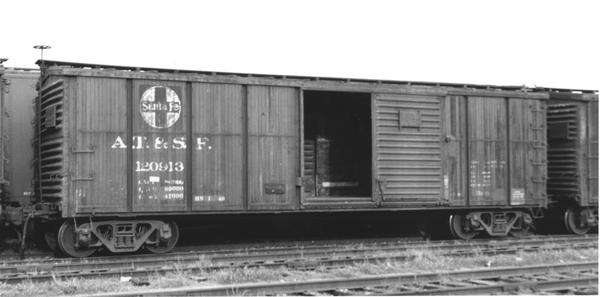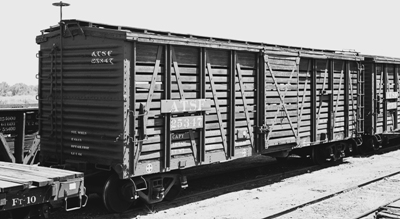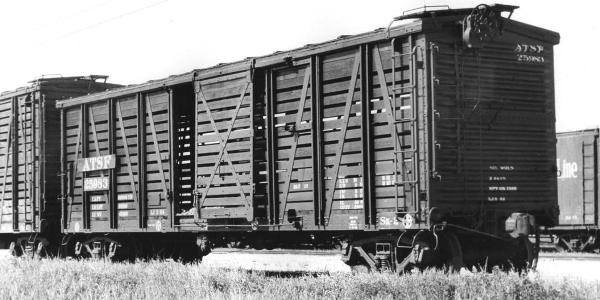Santa Fe Bx-3 and Bx-6 Class Sectional-Sheathed Box Cars
by Richard H. Hendrickson
At the turn of the twentieth century, the typical box car on the Santa Fe, as on most other major North American railroads, was a 36 foot 30 ton
car of all wood construction with a truss-rod underframe and arch-bar trucks. However, the universal adoption of knuckle couplers and air brakes
was making it possible to run larger cars in much longer trains, and by 1919 the Santa Fe was taking delivery of Bx-2 class 40 foot 40 ton USRA
box cars.
Designed and built by the United States Railway Administration during World War I, when the American railroads were nationalized,
these cars incorporated such advanced construction features as corrugated steel ends, riveted fishbelly steel center sills, and cast steel
Andrews trucks.
Though the 40 ton USRA cars still had double wood sheathed bodies with wood framing, it was becoming increasingly evident that steel body
framing afforded a major improvement in strength and durability; in fact, thousands of 50 ton capacity single sheathed box cars were also built
under USRA contracts which had steel superstructures with wood sheathing. As soon as the railroads were returned to private ownership, the
Santa Fe mechanical department began to develop box and automobile cars with steel framed, double wood sheathed bodies.
The result was a unique
and innovative design with inverted hat-shaped vertical posts, flat steel diagonals, and sections of exterior wood sheathing inserted in the open
spaces between the posts. These cars were stronger and more rigid, yet not significantly heavier, than their predecessors.
The Santa Fe's sectional-sheathed cars, though novel in concept, were in no sense experimental, and were ordered "off the drawing board" in
large numbers. 4,000 Bx-3 class box cars were built for the Santa Fe in 1923-'24 by Pullman, American Car & Foundry, and Standard Steel Car Co.
At the same time, Pullman delivered 1,000 Fe-P class 40 foot furniture and automobile cars and 500 Fe-Q class 50 foot cars which were similar in construction but were taller with wider door openings and had fishbelly steel center sills. Another 1,000 Bx-6 class box cars followed in 1925, as well as 500 more Fe-R class 50 foot automobile cars in 1926, making a total of 7,000 sectional-sheathed box and auto cars.
Construction of the Bx-3 and Bx-6 class box cars was state-of-the-art for their day, with 7-8 corrugated ends, flexible metal sheathed roofs,
and center sills fabricated from rolled steel channels. Instead of the customary wood sheathed doors, they had steel-framed doors with sheet
steel sheathing. Mechanical equipment included cast steel U-section Andrews trucks, KC air brakes, and vertical staff hand brakes.
As rapid progress in freight car design continued, larger and more modern box and auto cars overshadowed the Santa Fe's sectional sheathed cars
of the early to mid-1920s. However, the sectional sheathed cars proved to be reliable and economical in revenue service and continued to account
for a substantial part of the Santa Fe box car fleet for almost two decades, until thousands of larger steel sheathed cars began to arrive in
the late 1930s and early '40s.
Their only shortcoming was their plate steel doors, which were easily damaged. Steel angle reinforcements were
added to doors of early Bx-3s after delivery and applied to the doors when new on later Bx-3s and Bx-6s, but those proved to be a stopgap at
best and starting in the early 1930s, the original doors were replaced by more durable Youngstown corrugated doors.
With the railroads gearing up for American involvement in World War II, the small size of the Bx-3 and Bx-6 class cars rendered them increasingly
obsolete as general merchandise box cars, but their steel underframes and body framing were still structurally sound, so the Santa Fe found
another use for them by converting them into stock cars.
Between 1943 and 1946, 1,750 cars were rebuilt as Sk-2 class stock cars, and this
program continued until 1952 with the conversion of 1,120 sectional sheathed box cars into stock cars of class Sk-3 (with second-hand radial steel
roofs) and another 1,300 into Sk-5s (with new diagonal panel Murphy roofs).
As it turned out, these stock cars long outlasted the remaining
Bx-3 and Bx-6 class box cars. The sectional sheathed box cars steadily declined in numbers until, by 1965, only two Bx-3 class cars remained
on the active roster (numbers 116297 and 119758) and one Bx-6 (number 120530). The stock cars, on the other hand were progressively upgraded
with Ajax geared hand brakes, AAR trucks with integral journal boxes, and bottom-operated Type E couplers and in some cases were still earning
money for the Santa Fe in revenue service in the 1970s, sixty years after they were built.
Other uses were also found for obsolete Bx-3 and Bx-6 box cars. In the 1950s a number of them had 5 foot wide refrigerator car doors applied
for use in company ice service and were renumbered into the 188000 series. In addition, 200 Bx-6s had their exterior sheathing removed in 1952
and, as single sheathed cars, were assigned to zinc concentrate service and renumbered into the 40800-40999 series; a few of those cars lasted
as late as the early 1970s.
Beginning in the 1930s, many Bx-3s and Bx-6s were also assigned to maintenance of way duties when retired from revenue
service, sometimes with more or less extensive modifications depending on their intended use. On all of the cars that lasted into the 1950s,
whether in revenue or M-W service, AB air brakes replaced their original KC brake equipment, and some got Ajax geared hand brakes in place of
their vertical staff hand brakes.
In one form or another, then, the 5,000 sectional sheathed box cars delivered to the Santa Fe in the 1920s
returned their owner's capital investment in them several times over, with some cars surviving for well over half a century.

BX-6 photo by George Sisk, from the Charles Winters collection

Sk-2 photo with Vertical Brake Staff

Sk-2 photo with Power Brake
For more information on the SantaFe Railroad,
I recommend visiting the SantaFe Railroad Historical & Modeling Society. Please take a few minutes to visit this site on the internet and consider joining.













